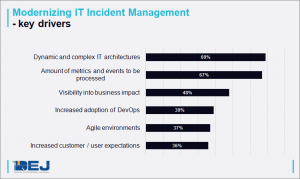Fifty-five percent of organizations in DEJ’s study on Modernizing IT Operations reported that they are looking to improve accuracy, timeliness and relevance of their IT alerting and notification capabilities. This is not a new issue, as organizations have been reporting challenges with alert overload, the number of false alarms and false positives and missed events for many years now. However, this issue is becoming even more critical in digital economy and the importance of effectively addressing it is primarily driven by the trends listed in the chart below.
DEJ’s analysis of strategies of Top Performing Organizations (TPO) for managing modern IT Operations identified 12 key areas where organizations should focus to improve their alerting, notification and resolution processes.
1 – Lifecycle approach. DEJ’s research shows that TPO are nearly 3 times more likely to be taking a lifecycle approach for IT alerting and incident management as compared to all others. This approach includes capabilities from having visibility into an entire infrastructure to policies for ongoing learning from previous incidents to improve an incident response in the future.
2 – Focus on resolution. TPO are defining their IT incident management strategies to go well beyond just alerting and notification and are incorporating a mix of capabilities that are focused on timely problem resolution, prevention and minimizing a risk to the business.
3 – Context. DEJ’s research shows that TPO are 84% more likely to have the ability to generate contextual alerts as compared to all others. In addition, 39% of the entire survey pool are looking to provide more context, such as priority, severity and correlation around their IT alerting and notification capabilities.
4 – Unified approach. Forty-one percent of organizations in DEJ’s research reported that they are using ten or more tools for IT performance monitoring. This is driving the need for organizations to centralize their alerting capabilities and provide a “single pane of glass” into their IT environments. DEJ’s research shows that organizations that are taking this approach are 81% more likely to improve the productivity of their IT staff.
5 – Machine learning. Due to the increase in volume and velocity of IT data to be processed, it is becoming humanly impossible to process terabytes of data and millions of metrics in real-time. Organizations that are using machine learning capabilities for IT incident management are reporting a 2.7 times better success rate in preventing performance issues, as compared to all others.
6 – Advanced analytics. Twenty-eight percent of organizations reported that they are looking to deploy an IT alerting solution based on anomaly detection, while another 26% are including predictive analytics in their IT incident management strategies. Deploying advanced analytics for IT incident management is one of the key differentiators from organizations simply understanding that they have a problem of timely prevention and resolution. TPOs are much more likely to be deploying these capabilities and, as a result, are reporting 48 minutes average mean time to resolution (MTTR) per incident as compared to 4.2 hours for all others.
7 – Proactive approach. Organizations are reporting, on average, 71% improvements in service availability when taking a proactive approach for managing IT performance. Organizations should be deploying IT incident management technologies with strong analytics capabilities that would help them identify potential issues before users are impacted.
8 – Visibility into entire infrastructure stack. TPO are 71% more likely to have the ability to aggregate alerts across an entire infrastructure stack as compared to all others. With the growing complexity of IT architectures being one of the key drivers for rethinking IT alerting strategies, having this capability is becoming increasingly important.
9 – Scalability. Fifty-nine percent of organizations reported scalability to be the key selection criteria for selecting IT incident management solutions. The need to process more metrics and events in a timely fashion is one of the key drivers for modernizing IT operations in general and this is especially true in the area of IT incident management.
10 – Automation. Forty-one percent of organizations reported that they are looking for more automation capabilities from their IT incident management solutions. These capabilities range from automated problem escalation to threshold management, recommendations and root cause analysis. Strength of automation capabilities is one of the key differentiators in this market and it allows TPO to free up 53% of their IT resources for innovation and transformation, as compared to 21% for all others.
11 – Collaboration, orchestration and knowledge management. As the complexity of IT incident management processes is increasing, organizations are recognizing the need to streamline these processes and put capabilities in place that would facilitate a collaboration between different teams. This is especially important in DevOps and Agile environments and DEJ’s research shows that organizations are increasingly looking to invest in these types of capabilities – two way communication (37%), integration with communications platforms (34%), incident documentation management (24%).
12 – Business impact. DEJ’s research shows that 47% of IT Operations professionals are looking to get more visibility into business value provided. As organizations are increasingly looking to digitize their processes and make IT more strategic, they are becoming more interested in IT incident management solutions that provide visibility into the impact of IT incidents on key business goals.
Alerting and notification capabilities are designed to be a part of a solution for preventing and resolving issues, but they are now becoming a part of that same issue. Organizations are looking for more intelligence, automation and visibility, at scale, from technology solutions, as well as a more clear path from a notification to a resolution of a problem. Addressing this issue requires a strategic approach that includes integration with other reporting tools (ITSM, DevOps management, infrastructure and application performance monitoring, Continuous Delivery, etc.) and more intelligence when it comes to policies and scheduling.
DEJ’s Modernizing IT Operations for Digital Economy study shows that the road to becoming a digital business runs through IT Operations, but IT Operations need to be modernized to enable Digital Transformation. IT incident management is a core part of modern IT Operations and addresses some of the key areas of the path to becoming a digital enterprise. However, in order to turn IT alerts from a source of noise and inefficiencies to a technology source of competitive advantage, organizations should work to incorporate each of the 12 areas above into their IT strategies.














